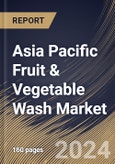The Asia Pacific Fruit & Vegetable Wash Market would witness market growth of 6.9% CAGR during the forecast period (2023-2030). In the year 2021, the Asia Pacific market's volume surged to 1016.0 Tonnes, showcasing a growth of 5.4% (2019-2022).
The fruit & vegetable wash market encompasses the production, distribution, and consumption of cleaning solutions and products designed specifically for the washing and sanitation of fruits and vegetables. It includes a range of products such as liquid washes, sprays, wipes, and concentrates formulated to remove dirt, pesticides, wax, bacteria, and other contaminants from produce surfaces.
Furthermore, the significance of the fruit & vegetable wash market extends beyond mere hygiene, it underscores broader trends shaping consumer behavior, industry dynamics, and regulatory frameworks. Heightened awareness of foodborne illnesses and stringent regulatory standards and certifications have underscored the importance of implementing robust washing and sanitation practices across the food industry. Moreover, as consumers increasingly prioritize products that align with their health, safety, and environmental sustainability values, the demand for natural, organic, and eco-friendly washing solutions continues to surge.
The growth of India's hotel industry and food service sector presents opportunities for the fruit and vegetable wash market to expand its presence and meet the increasing demand for safe and hygienic produce across various food service establishments. Hence, the expanding food service industry and growing disposable income in the region propel the market's growth.
The China market dominated the Asia Pacific Fruit & Vegetable Wash Market by Country in 2022, and would continue to be a dominant market till 2030; thereby, achieving a market value of $433 million by 2030. The Japan market is registering a CAGR of 6.2% during (2023 - 2030). Additionally, The India market would showcase a CAGR of 7.6% during (2023 - 2030).
Based on Type, the market is segmented into Synthetic, and Natural. Based on End-user, the market is segmented into Household, Commercial, and Institutional. Based on Product, the market is segmented into Liquid & Sprays, Powder, and Others. Based on Distribution Channel, the market is segmented into Supermarkets and Hypermarkets, Online, Convenience Stores, and Others. Based on countries, the market is segmented into China, Japan, India, South Korea, Singapore, Malaysia, and Rest of Asia Pacific.
The fruit & vegetable wash market encompasses the production, distribution, and consumption of cleaning solutions and products designed specifically for the washing and sanitation of fruits and vegetables. It includes a range of products such as liquid washes, sprays, wipes, and concentrates formulated to remove dirt, pesticides, wax, bacteria, and other contaminants from produce surfaces.
Furthermore, the significance of the fruit & vegetable wash market extends beyond mere hygiene, it underscores broader trends shaping consumer behavior, industry dynamics, and regulatory frameworks. Heightened awareness of foodborne illnesses and stringent regulatory standards and certifications have underscored the importance of implementing robust washing and sanitation practices across the food industry. Moreover, as consumers increasingly prioritize products that align with their health, safety, and environmental sustainability values, the demand for natural, organic, and eco-friendly washing solutions continues to surge.
The growth of India's hotel industry and food service sector presents opportunities for the fruit and vegetable wash market to expand its presence and meet the increasing demand for safe and hygienic produce across various food service establishments. Hence, the expanding food service industry and growing disposable income in the region propel the market's growth.
The China market dominated the Asia Pacific Fruit & Vegetable Wash Market by Country in 2022, and would continue to be a dominant market till 2030; thereby, achieving a market value of $433 million by 2030. The Japan market is registering a CAGR of 6.2% during (2023 - 2030). Additionally, The India market would showcase a CAGR of 7.6% during (2023 - 2030).
Based on Type, the market is segmented into Synthetic, and Natural. Based on End-user, the market is segmented into Household, Commercial, and Institutional. Based on Product, the market is segmented into Liquid & Sprays, Powder, and Others. Based on Distribution Channel, the market is segmented into Supermarkets and Hypermarkets, Online, Convenience Stores, and Others. Based on countries, the market is segmented into China, Japan, India, South Korea, Singapore, Malaysia, and Rest of Asia Pacific.
List of Key Companies Profiled
- The Procter & Gamble Company
- Unilever PLC
- Wipro Limited
- Dabur India Ltd.
- Diversey Holdings Ltd. (Solenis LLC)
- ITC Limited
- Marico Limited
- Maclin Sourcing Solutions Ltd.
- Hebei Baiyun Daily Chemical Co., Ltd.
- Veg Wash Plus
Market Report Segmentation
By Type (Volume, Tonnes, USD Billion, 2019-2030)- Synthetic
- Natural
- Household
- Commercial
- Institutional
- Liquid & Sprays
- Powder
- Others
- Supermarkets and Hypermarkets
- Online
- Convenience Stores
- Others
- China
- Japan
- India
- South Korea
- Singapore
- Malaysia
- Rest of Asia Pacific
Table of Contents
Chapter 1. Market Scope & Methodology
Chapter 2. Market at a Glance
Chapter 3. Market Overview
Chapter 5. Asia Pacific Fruit & Vegetable Wash Market by Type
Chapter 6. Asia Pacific Fruit & Vegetable Wash Market by End-user
Chapter 7. Asia Pacific Fruit & Vegetable Wash Market by Product
Chapter 8. Asia Pacific Fruit & Vegetable Wash Market by Distribution Channel
Chapter 9. Asia Pacific Fruit & Vegetable Wash Market by Country
Chapter 10. Company Profiles
Companies Mentioned
- The Procter & Gamble Company
- Unilever PLC
- Wipro Limited
- Dabur India Ltd.
- Diversey Holdings Ltd. (Solenis LLC)
- ITC Limited
- Marico Limited
- Maclin Sourcing Solutions Ltd.
- Hebei Baiyun Daily Chemical Co., Ltd.
- Veg Wash Plus
Methodology

LOADING...








